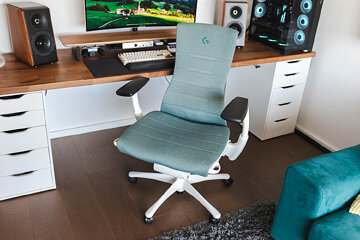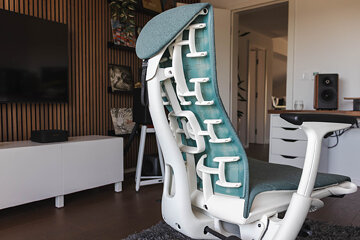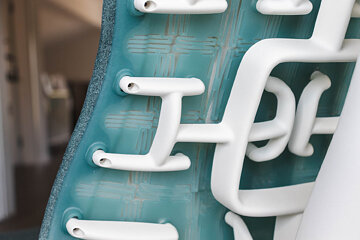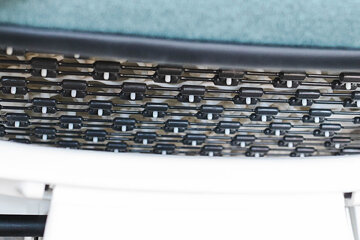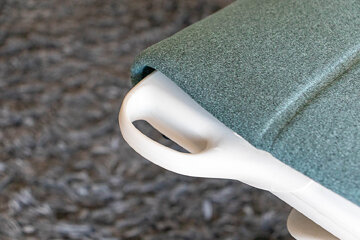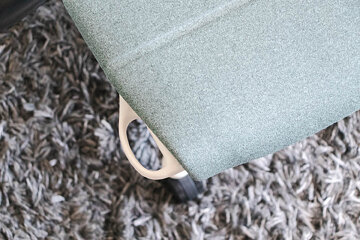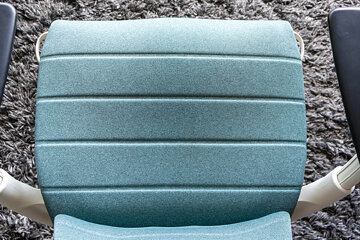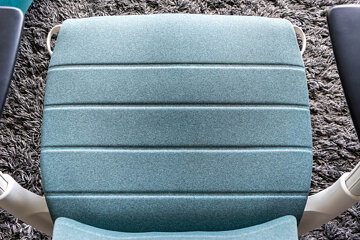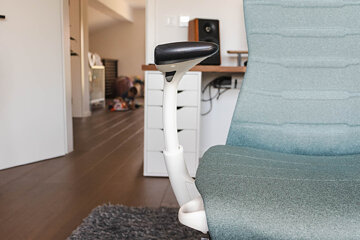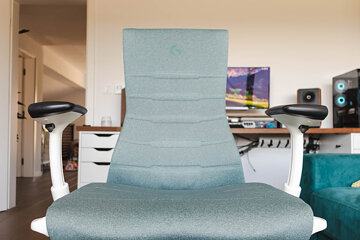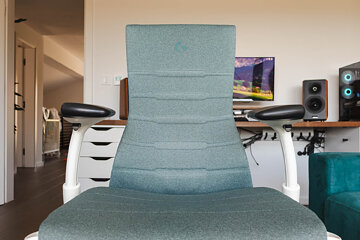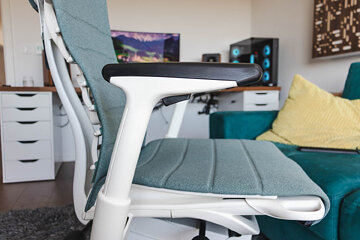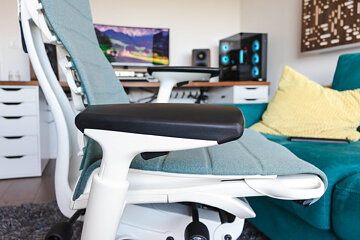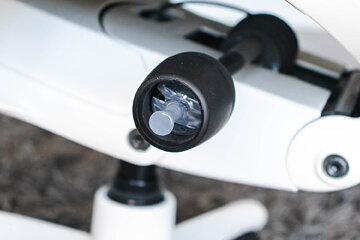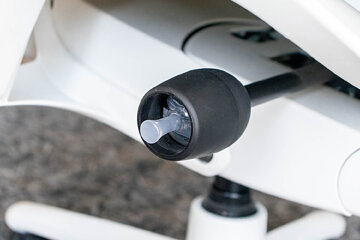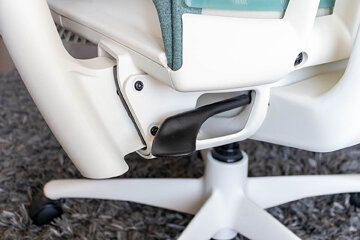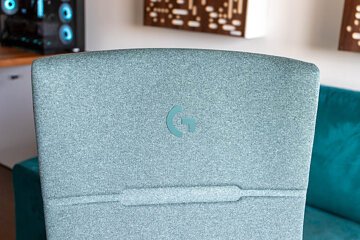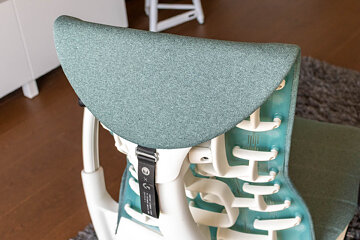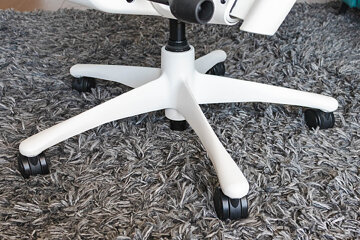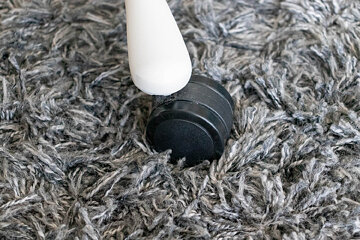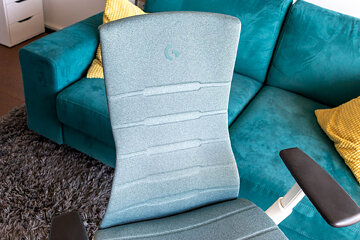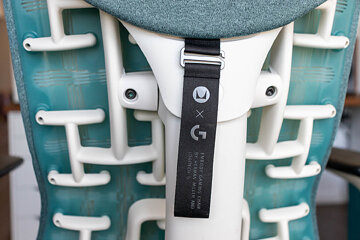 19
19
Herman Miller Logitech G Embody Review - No Pain, No Gain
User Experience »Closer Examination and Setup
We usually start our reviews by going over the packaging and contents, but the box this chair arrived in is long gone. What I can tell you is that the Embody ships in a huge, robust cardboard box and comes fully assembled. You don't have to do anything other than open the box from the side, roll the chair out, and remove a few pieces of protective foam. From a user experience perspective, that's a huge plus compared to most other chairs—gaming or otherwise—which often require hours of assembly. With the Embody, it takes less than 10 minutes from the moment it's delivered until you're sitting in it.
As mentioned in the introduction, the most distinctive aspect of the Embody is its rear exoskeleton. The exoskeleton is attached at around thirty points to an extremely flexible piece of plastic that, in practice, really does respond to even the smallest movements of your back muscles, mimicking the spine. If you decide to slouch, you'll feel the upper part of the backrest stretch; return to a more natural posture, and the backrest instantly realigns, gently hugging your shoulders. Lean to the left and the entire left side of the backrest stretches—and the same happens on the right. In short, Embody's backrest truly moves with the user in a way I haven't experienced with any other chair I've ever sat in.
A "pixelated" mesh, conceptually similar to the one found in the backrest, is also located beneath the seat. It's denser in this area, likely because it needs to respond even more precisely to lower body movements and distribute weight evenly, as it bears a greater portion of the user's mass. The seat itself is spacious, measuring 55 cm in width and 50 cm in depth when fully extended. It's only slightly concave and covered in fabric from edge to edge—excellent news for users who occasionally rest a leg on the chair or sit cross-legged. On chairs with sloped seat edges, like the Aeron, such positions aren't feasible. I'd describe the firmness as medium, but thanks to the same flexible plastic structure used in the backrest, the seat nicely yields under your weight, conforming to your body. The result is a surface that feels supportive without being rigid—a firm seat designed for long-term comfort, that remains genuinely pleasant to sit on.
Adjusting the seat depth is done by gently lifting and pulling two levers located on the left and right sides of the seat's front edge. The seat should be extended to a point where there's a two- to three-finger gap between the front edge of the seat and the back of your knees.
Compared to the seat and backrest, which adapt to micro-movements and "breathe" with your body, the armrests are surprisingly limited. They can only be raised and lowered (with a range of 12 centimeters), and tilted left or right—meaning they can be moved closer to or farther from your torso while seated. In comparison to the "4D" armrests on Steelcase's Leap V2, which can also move forward and backward and rotate left and right, or those on the Gesture, where the armrests offer virtually unlimited movement in every imaginable direction, the Embody falls short. It trails behind all the aforementioned models, as well as many other modern office chairs. Although I was generally able to find a satisfactory height and angle for comfortable typing and mouse use, I still occasionally wished I could move the armrests just a few millimeters in some direction. That small adjustment would elevate their position from satisfactory to perfect. No such luck.
The seat adjustment options are excellently executed. On the right side, underneath the seat, there's a small lever that unlocks the height adjustment mechanism. The seat height can be set within a range of 45 to 59 centimeters, measured from the floor to the top surface of the seat. As usual, the goal is to achieve a setting where your thighs are parallel to the floor.
Surrounding the height adjustment lever is a dial used to adjust the amount of force required to recline the backrest. The Embody cannot be permanently locked into a specific recline angle—that would go against its core principle of continuous adjustment to the body's natural movements. Instead, it offers four predefined recline positions, selectable using a lever on the left side near the junction where the exoskeleton connects to the seat. Once you find your optimal recline angle—for me, it was the first position after the fully upright one—you can then use the tension dial to define how much force is needed for the backrest to recline to that position. There are no universal rules here. Some users may prefer firmer resistance, while I personally favor a relatively light force, since that first reclined position feels more natural than any of the "in-between" ones. And don't worry if you don't get it right immediately. Living with the Embody has a thorny beginning, filled with countless adjustments and moments of frustration that might make you curse the day you bought it.
On the lower right side of the exoskeleton, there's a knob for fine-tuning the backrest curvature—a function Herman Miller calls "BackFit Adjustment." Turning the knob forwards increases the curvature of the backrest, causing it to "hug" your shoulders more closely. Turning it backwards flattens the backrest, easing pressure on the upper back while increasing lumbar support. A good starting point for dialing in the BackFit is to sit upright with your back fully pressed against the backrest, look straight ahead, and start turning the knob forwards from its fully flat position. At a certain point, you'll feel the upper corners of the backrest begin to close in around your shoulders—that's when you know you're approaching an optimal setting. However, because this adjustment interacts with your chosen recline tension, finding the perfect combination can take several days—or even weeks.
Herman Miller is so confident in the ergonomic benefits of the Embody's exoskeleton that the chair doesn't come with a headrest. Some third-party manufacturers, such as Atlas, offer aftermarket solutions (theirs costs around $250), but if you ask Herman Miller, they'll tell you a headrest doesn't belong on the Embody.
The five-star base is made of die-cast aluminium. It sits on the surface on five double-wheel casters, which are wrapped in soft polyurethane. After a year of daily usage, they have yet to leave a single mark on my oak hardwood floor.
Differences from "regular" Herman Miller Embody
The Herman Miller Logitech G Embody Gaming Chair is a "gaming" version of the Embody chair, launched in collaboration between Herman Miller and Logitech. The idea behind it was simple: leverage Logitech's strong reputation in the gaming space to make this premium chair more appealing to gamers, a group that typically doesn't shop in the $1,500 price range for office chairs. Logitech added a few of its own touches to the design. These include an engraved "G" logo on the upper part of the backrest, cut-out indentations in the backrest frame, and additional layers of foam beneath the seat and along the spine area, presumably to increase long-term comfort during extended gaming sessions. There's also a fabric strap featuring both the Herman Miller and Logitech logos hanging from a hook on the back of the chair—something the target audience seems to love, though I can't say I understand why.
Finally, the "gaming" Embody is available in three additional color options besides the standard black: Cyan (black fabric and base, dark blue backrest), Amethyst (purple fabric, white backrest and base), and Galaxy (teal fabric, white backrest and base—that's the one you see on all of my photos). All four versions use the refined, triple-stitched Sync fabric, which is an optional upgrade on the standard Embody. By contrast, the regular Embody comes factory-equipped with the coarser Rhythm fabric.
Jul 28th, 2025 22:04 CDT
change timezone
Latest GPU Drivers
New Forum Posts
- Mouse and CPU usage. (5)
- Warning about DOCP (32)
- Intel CC150 Submission for Forum (2)
- TPU's Nostalgic Hardware Club (20581)
- Windows 12 (236)
- need 2tb + SATA SSD ASAP!!! needs to be reliable and not entry level crap (4)
- 2022-X58/1366 PIN Motherboards NVME M.2 SSD BIOS MOD Collection (948)
- What antivirus do you use? (37)
- Upgrade from old x58 system (48)
- Kindly help me to complete my new PC build... (19)
Popular Reviews
- Herman Miller Logitech G Embody Review - No Pain, No Gain
- Lian Li O11 Dynamic Mini V2 Review
- Upcoming Hardware Launches 2025 (Updated May 2025)
- Noctua NF-A12x25 G2 PWM Fan Review
- VAXEE XE V2 Wireless Review
- AQIRYS Sirius Pro Review
- Sapphire Radeon RX 9060 XT Pulse OC 16 GB Review - An Excellent Choice
- AMD Ryzen 7 9800X3D Review - The Best Gaming Processor
- UPERFECT UMax 24 Review
- NVIDIA GeForce RTX 5050 8 GB Review
TPU on YouTube
Controversial News Posts
- AMD's Upcoming UDNA / RDNA 5 GPU Could Feature 96 CUs and 384-bit Memory Bus (134)
- AMD Radeon RX 9070 XT Gains 9% Performance at 1440p with Latest Driver, Beats RTX 5070 Ti (131)
- NVIDIA GeForce RTX 5080 SUPER Could Feature 24 GB Memory, Increased Power Limits (115)
- Intel "Nova Lake-S" Core Ultra 3, Ultra 5, Ultra 7, and Ultra 9 Core Configurations Surface (109)
- NVIDIA DLSS Transformer Cuts VRAM Usage by 20% (100)
- DDR6 Memory Arrives in 2027 with 8,800-17,600 MT/s Speeds (99)
- AMD Sampling Next-Gen Ryzen Desktop "Medusa Ridge," Sees Incremental IPC Upgrade, New cIOD (97)
- Intel CEO Confirms SMT To Return to Future CPUs (95)
